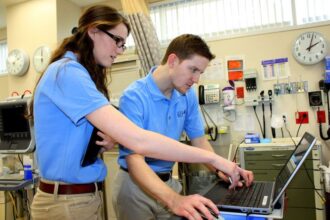This is the transcript of my recent podcast interview with Dr. Bruce Bethancourt, chief medical officer of St. Vincent Medical Group.
This is the transcript of my recent podcast interview with Dr. Bruce Bethancourt, chief medical officer of St. Vincent Medical Group.
David E. Williams: This is David Williams from the Health Business Group. I’m speaking today with Dr. Bruce Bethancourt. He is Chief Medical Officer of Saint Vincent Medical Group.
Bruce, could you first describe Saint Vincent Medical Group and what your role is there?
Dr. Bruce Bethancourt: Saint Vincent Medical Group is a relatively new group that came together three years ago. It’s really three groups. We have an amazing group of cardiologists that have been focused on quality care for more than 20 years. There is another group, who are cardiothoracic and cardiovascular surgeons that came in about two and half years ago. Then, the Saint Vincent Physician Network, which is a group of primary care physicians that came in two and half years ago as well. These groups came together and we’re now in the middle of developing a culture of patient-centric, high quality and high touch care. It’s a work in progress.
My role as the CMO is to continue to bring the group together to become a cohesive, integrated physician group. Right now, we’re about 500, and when the pediatrics specialists folds in over the next year, we’ll add another 200. We should be 700 in total. We’re developing a culture of quality; moving towards the patient-centric model of medical home for our primary care docs and developing the patient-centered neighborhood with our specialists.
Williams: Bruce, what is the geographic scope that you cover?
Bethancourt: We cover the lower two-thirds of Indiana.
Williams: As you look toward putting these groups together and developing a culture and working these patient-centered areas, what are some of the key challenges and opportunities that you’re dealing with?
Bethancourt: The biggest challenge right now is dealing with the Affordable Care Act. We’re going from a traditional model of one-on-one, one physician and one patient at a time, to more team-based care. And it’s a bit of a challenge that we really don’t have enough physicians in the United States to allow for one-on-one care. We have 40 million more Americans insured, so we really need to function as a team as opposed to the one-on-one manner.
And so we’re moving from one-on-one to team-based care, which is a very gradual process. We’re living in two worlds, a fee-for-service world and then an increasing at- risk world. And so it’s that transition that’s a challenge.
Williams: I know you described some of the impetus for moving toward team-based care. Would you say that team-based care in the world of the Affordable Care Act is a necessary evil or are there some advantages to it once you make it there?
Bethancourt: I look at it as a very positive thing because some of the things that physicians do today are things that can be done by someone else. I think there are things that the support staff can take care of for the physician. For example, closing the gaps in care. We know what the preventive health measures are and what needs to be done: utilizing others to order mammograms that are overdue, or to order patient visits that are overdue, and not relying on the physician to do that.
Also, with the appropriate predictive analytics, we can identify those patients. And it’s really about supporting a physician so the physician can do what they do best, which is cognitive thinking about what’s best for patients as opposed to trying to remember everything that needs to be done for the patient.
Williams: There’s been a big focus over the past few years on electronic health record implementation. I know you’re bringing multiple groups together, but what has been the strategy for EHR deployment and where do you stand with the EHR today?
Bethancourt: We are moving quickly into athenaClinicals. We have disparate EMRs, which really presents a problem. But hopefully, by summer, we will have all of our physicians on athenaClinicals. One nice thing about athenaClinicals –and none of the EMRs are perfect– but athenaClinicals will help us close the gaps in care.
Then we really need to look for the appropriate analytic tool that will help us reach out to those patients that have gaps in care, or that we can identify as being high-risk, so that we will focus on those patients before they reach the tipping point and either end up in the hospital or have a bad outcome in some way.
Williams: You mentioned analytics. Can you talk a little bit about use cases and provide an example?
Bethancourt: Well, there are two. Right now we’re doing a pilot with Milliman. What we’ve seen is that most physicians know their patients and take good care of them. But then there is the example of a 75-year old grandmother who has an eighth-grade education, has COPD yet still smokes, is widowed, maybe slightly depressed, has diabetes, hypertension and hyperlipidemia. She doesn’t go to her doctor. She doesn’t get a flu shot, ends up getting pneumonia, ends up on a ventilator in the hospital for 30 days and then it turns to six weeks of care. If we have the ability to reach out to that person before they reach the tipping point, their outcome is much better and the cost is lower. The predictive analytics can really provide value to that patient.
Another example comes from our pilot with Acupera. Acupera has some predictive analytics that are really useful. It helps us identify gaps in care. For example, it identifies the patient who is on two different medications that are really contraindicated when used together. We can optimize treatment by increasing the dose of a particular medication, or identifying certain patients, for example, the diabetic and the need to be on an ACE inhibitor. It can really help the physician do the right thing. So those are two particular cases where I think the next couple of years will greatly improve the outcomes of care.
Williams: What you described with Acupera, understanding the flow and different medications that are contraindicated and so on, is that information already available in the EMR or from some other source? How much of an incremental improvement is it compared to something very different?
Bethancourt: It’s huge, because EMRs of today – even the best ones –still have problems. I liken many of them –but not all– to a junkyard. All the parts are there but you can’t get a car out of it. And that’s the case with many of the EMRs… Athena is much better than what we have now; it will come up with some gaps in care and help with reporting. But I don’t think any EMRs that I have seen really have the predictive analytics of Milliman or Acupera, or even Humedica.
Williams: You mentioned identifying some of these patients and getting them on a better care path. How then does that relate to your cultural initiative and making sure that the patient has the right kind of experience when they’re encountering different members of the team? How do you improve care to that 75-year-old woman you described, who probably doesn’t have a great time when she goes to the doctor? How does the technology work with the cultural aspects to make that happen?
Bethancourt: I think culturally, if your doctor’s office is calling you and saying, “Hey, we just noticed that you’re missing your flu shot and we’d like you to stop in to get your flu shot. And how’s it going with you quitting smoking?” If someone cared enough to call me, to call a patient, I think that would be monumental care. And I think that a lot of patients figure, “Well, if I don’t hear from them, they don’t care. If they don’t care, it must not be important.” I think being able to reach out proactively to your patients is going to be very satisfying to those patients.
I think that it’s going to be huge. And working as a team as opposed to just waiting on the doctor, I think it’s going to be very important that the patients have better connectivity to their health care.
Williams: I understand the opportunity for improvement by bringing these groups together, moving over to a new EMR and trying out these new vendors. But how do you measure success? And in particular, maybe as you look to some of these external IT tools, how do you determine if they’re being successful? How do you improve the usage over time?
Bethancourt: Well it’s about closing the gaps in care. Are 85 percent of our patients getting the appropriate hemoglobin levels? Are our diabetics getting their A1C? Are we reaching out to patients so that our ambulatory sensitive admission is lower and our new admissions rate is lower? I think a lot of it is going to be process measures, unfortunately. But as we move along, we’re going to start seeing outcome measures. We’ll start to see we’re taking great care of them and doing all the right things for a particular diabetic, for example. But over the next five years we need to see if there is a decrease in admissions, and that for those that get admitted for various reasons the length of stay is less or the outcomes are better because of the care we’ve been providing to them.
Right now, we need to look at process measures but ultimately, it’s going to be actual outcomes.
Williams: I know that you can’t do everything at once and you talked about the need to start with process measures before moving on to outcome measures. What’s reasonable to expect? What are your ambitions for five or even seven years from now when you work through all the different issues, get better technologies in place and are really humming? What will be different and how will the patient’s experience be different?
Bethancourt: Well, what I will see as a success in the next five to seven years is that all of our primary care will be functioning at a team level. Their panel size will probably, we’re hoping, have doubled. Our patient satisfaction will be high, our quality outcomes will be high. And as a team we are reaching out to more patients than we’re reaching out to now, and having better outcomes.
Williams: Is there anything that we haven’t covered that you’d like to make sure we discuss today?
Bethancourt: One of the things that we’re doing is centered on the continuity of care. One of the biggest problems we see right now is that the hospital by and large takes really good care of patients and then “lets them out the door.” Patients get discharged in the hospital and don’t understand their medications. They’re not sick enough to remain in the hospital but they’re still too sick to be in the hands of a primary care doc who’s seeing anywhere from 25-30 patients a day.
And so, we’re trying to promote the continuity and coordination of care. We’re opening up a transitional clinic, which will be for the high-risk patient coming out of the hospital. It will be similar to an ambulatory critical care clinic. We’ll take care of those really high-risk patients for two to four weeks and try to stabilize them enough so that they can go back to their primary care doc and prevent that patient from having to be readmitted to the hospital. They need the extra care in having navigators coordinate their care. And we also have our remote care monitoring for heart or acute patients coming out of the hospital. We’re going to monitor for free for 30 days to make sure everything’s going well.
Williams: This is David Williams with the Health Business Group. I have been speaking today with Dr. Bruce Bethancourt, chief medical officer at Saint Vincent Medical Group.









